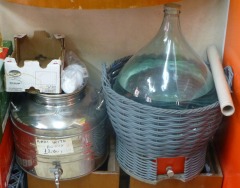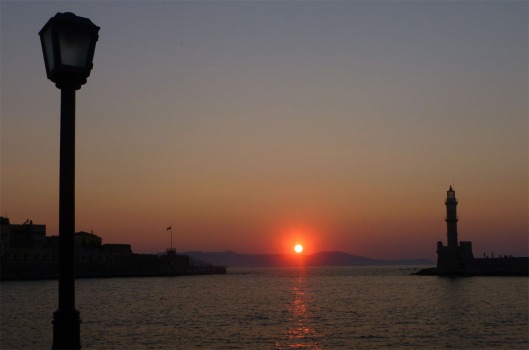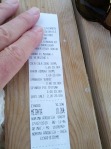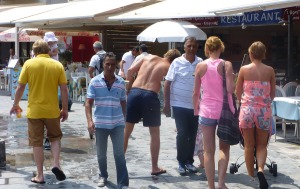Tags
Two weeks. That’s how long we’ve been in Chania. We’ve pretty well scoured the city (it’s small: population ~55,000) and are now taking an inventory of all the beaches within a day’s outing. Louise is learning the language (note the absence of the plural “we”), and we’re becoming gourmands, having now visited – oh, I dunno – maybe 500 local restaurants. (Lord, thank you for the food on this island.)
But now, some of the things we’ve learned (and that you won’t read in the guidebooks) about the local culture:

Homemade raki jugs in the market across the street. The metal jug holds raki sweetened with honey. Click to enlarge (all photos).
Raki Here in Chania, raki flows like politicians’ promises. Many little grocery stores and restaurants produce their own, distilling the skins and stems (pomace) left over after wine production. Sometimes, distillation is done twice, striving to produce an aperitif that’s at least 90 proof. In Chania, like Spain, you can occupy a restaurant’s table as long as you like – all night if you wish – until you call for the check. When you do, the check is presented along with a little carafe of raki (and, most often, several slices of cold watermelon – all at no charge).
We have been known to quaff our free raki, pay the bill, and trundle off to a waterfront restaurant (where the tourist watching is best) for another carafe. Or two. Double raki nights pretty much preclude doing anything the next day.
English Almost everyone speaks it. Tourists here come primarily from Scandinavia, with a few Germans and Italians representing Europe. None of them speak Greek, so they all fall back on English, which seems to be a common lingual denominator. Coming from Girona, where everyone speaks Catalan and you’d better too, the English we hear around here is a relief.
(Note: Most signage is not in English. It’s in the Greek language and the Greek alphabet. With Catalan, we could often sound out signage and arrive at meanings; not so in Greece. Try sounding out Ρακί μας είναι η καλύτερη στα Χανιά.)
The VAT Not everything is to love in Greece. The 23% VAT (Value Added Tax) is especially abusive. A twenty-euro dinner is a twenty-five euro dinner as far as we, the consumers, are concerned. That’s gotta be especially tough on sellers, who have to fork over almost a quarter of their sales to the government, while all the buyers see is the bottom line. No wonder the Greeks demonstrate!
Black Pants How do you tell the Greek men from the tourists? It’s warm here, so most men wear sandals and shorts, but a true Greek wears long pants, usually black (blue jeans too), with socks and shoes, no matter what the weather. Giorgio Armani would be right at home. (In fact, he was right at home here a few days ago, having parked his yacht just outside the harbor and wandered ashore to sample a Chania restaurant. We hope he visited Taverna Strata, our favorite.)
The Weather The weather’s perfection here is almost monotonous. Every day has been cloudless since we arrived, with temperatures in the mid-eighties, very little wind, and glorious sunsets (see photo at the top of this post). It’s just right for lazing on the beaches we’ve been inventorying, which takes me back to the beginning of this post, and perfect closure. Αντίο!






Hoping you can get to Knossos and over to the other coast as well, so much to see!
Loved the museum at Heraklion too.
LikeLike
Thanks, Molly. In fact, we’re headed for Knossos tomorrow, and we’ll spend the day August 30 in Heraklion. Great minds…
LikeLike
Whoa, a 23% VAT? I thought New Zealand had it bad with 15%. That’s pretty punishing for businesses and consumers. I’m glad it didn’t stop you from enjoying every restaurant on the island though 🙂
LikeLike
Pointing out the every-day bits like the VAT on your receipt is one of the reasons I enjoy your blog. Well, that and that you look at and comment on things that also interest me! As a westerner, that whole “until you call for your check” thing has taken me a bit to become accustomed to – initially, we thought that our servers were simply being lazy. Not so! Thanks for another great peek.
LikeLike